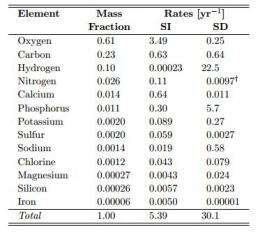April 11, 2012 report
Research duo calculate possible number of WIMPs striking our bodies

(Phys.org) -- Katherine Freese and Christopher Savage from the University of Michigan and Stockholm University respectively have embarked on a whimsical bit of physics research. They’ve been estimating the number of Weakly Interacting Massive Particles (WIMPS), thought by some to be instances of dark matter; that stuff that fills in the holes in physics theories that can’t be explained any other way, that likely strike the human body on a yearly or even minute by minute basis. They have found, as they describe in their paper they’ve uploaded to the preprint sever arXiv, that in their estimation, billions of WIMPS pass through every human body on Earth every second. But only a small fraction of those actually hit something such as the nuclei of an oxygen or hydrogen atom. They say most assumptions about dark matter would put the collision rate at something like thirty times a year. If new data is taken into account however, they suggest the hit rate could be closer to 100,000 a year, or one every minute or so.
Dark matter is a touchy subject in physics. No one has found any proof that it really exists, yet countless theories rest on its existence because there has to be something there to explain huge discrepancies in basic physic theories involving gravity and mass. Why for example, does the entire mass of a galaxy add up to less than the amount necessary to exert the gravity effects seen that keep its structure intact? Physicists say it’s because there is a quantity of mass that cannot be seen or measured that makes up the difference, so-called dark matter. But if that is so, then it stands to reason it must be here around us all, every day, moving through everything we can see, including our own bodies. And that’s why Freese and Savage turned to math to try to find out how much there should be, if it does indeed exist.
Their calculations are based on findings of researchers working with particle detectors buried under mountains in various locales that go by names like DAMA, CRESST and CoGeNT. There scientists have set up huge pools of liquid materials with crystals that light up when struck by neutrinos and other sub atomic particles. Such detectors can theoretically be used to detect the presence of dark matter particles as well by measuring the recoil in observed strikes, and one of them, DAMA claimed to have done so at one point, but those results were not reproducible by others.
Frees and Savage used such measurements to make their calculations, which while interesting, don’t appear to actually add much to the understanding of dark matter or offer any new clues as to whether it really exists. But their research does bring up some obvious questions such as, what happens to our bodies when (if) they are struck by such particles, and is it all a part of some of the areas in biology we really don’t understand, such as how life came to exist in the first place or how does a lump of grey organic matter give rise to consciousness?
More information: Dark Matter collisions with the Human Body, arXiv:1204.1339v1 [astro-ph.CO] arxiv.org/abs/1204.1339
Abstract
We investigate the interactions of Weakly Interacting Massive Particles (WIMPs) with nuclei in the human body. We are motivated by the fact that WIMPs are excellent candidates for the dark matter in the Universe. Our estimates use a 70 kg human and a variety of WIMP masses and cross-sections. The contributions from individual elements in the body are presented and it is found that the dominant contribution is from scattering off of oxygen (hydrogen) nuclei for the spin-independent (spin-dependent) interactions. For the case of 60 GeV WIMPs, we find that, of the billions of WIMPs passing through a human body per second, roughly ~10 WIMPs hit one of the nuclei in the human body in an average year, if the scattering is at the maximum consistent with current bounds on WIMP interactions. We also study the 10-20 GeV WIMPs with much larger cross-sections that best fit the DAMA, COGENT, and CRESST data sets and find much higher rates: in this case as many as $10^5$ WIMPs hit a nucleus in the human body in an average year, corresponding to almost one a minute.
via Arxiv Blog
© 2012 Phys.Org


















